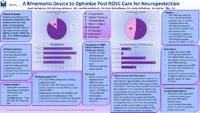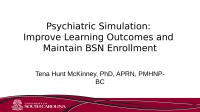A mnemonic device to optimize post ROSC care for neuroprotection
View File(s)
- Author(s)
- Details
-
Noah McManus, ADN, RN; Brittany Atkinson, BSN, RN; Jennifer Krebsbach, BSN, RN; Patrick McKinney, BSN, RN, CEN; Andrew Mittelman, BS, RN, CEN; Jordan W. Tiller, BSN, RN, CEN, TCRN
- Sigma Affiliation
- Non-member
Visitor Statistics
Visits vs Downloads
Visitors - World Map
Top Visiting Countries
| Country | Visits |
|---|
Top Visiting Cities
| City | Visits |
|---|
Visits (last 6 months)
Downloads (last 6 months)
Popular Works for McManus, Noah by View
| Title | Page Views |
|---|
Popular Works for McManus, Noah by Download
| Title | Downloads |
|---|
View Citations
Citations
Session H presented Friday, September 28, 2:30-3:30 pm
Purpose: Emergency department and EMS resuscitation teams sometimes achieve return of spontaneous circulations in cardiac arrest patients. These patients are then very vulnerable to neurological injury for various reasons. The nurses in our department developed a mnemonic device using the word OPTIMIZE aimed at avoiding brain damage after cardiac arrest and ROSC. The device was designed to organize treatment teams, goals and the interventions needed to achieve these goals to provide neuroprotection to ROSC patients. Some of the neuroprotective strategies included are tight SpO2 and EtCO2 control, targeted temperature management, maintenance of target MAP to support adequate CPP, tight glucose control and addressing metabolic derangements.
Design: This project started out as a process improvement initiative in our department. Our shared governance councils worked on design and implementation. Our education council developed the device and presented the concept to our staff with an opportunity to practice using it in a simulation environment at our annual skills day. The professional development council thought it would be a good topic to for a poster presentation or paper, and resolved to submit an abstract. Setting: This project was implemented in an urban emergency department. This facility is a level 1 trauma, chest pain, comprehensive stroke and burn center.
Participants/Subjects: The mnemonic device was used for patients who had cardiac arrest and ROSC in the pre-hospital or emergency department setting. Those using the device are multidisciplinary teams comprised of emergency department nurses, MDs, PAs, techs, pharmacists, respiratory therapists, and ancillary staff.
Methods: Each letter of the word OPTIMIZE was printed in 128pt font on a landscape oriented piece of paper. Next to each letter (in smaller type) are related treatment goals, interventions, current state and desired state physiological parameters. For example, 'O' for oxygenation, 'P' for pressure and so on. On each sheet there is also a spot to note which team member will be working on the interventions needed to reach the goals. The eight sheets were laminated and connected to form a vertical banner 1ft wide x 6ft tall, which was posted on the walls in our resuscitation bays. After ROSC is achieved; and ABCs are confirmed, the code team leader calls a 90 second time-out and the team goes down the banner to address identified needs. A dry erase marker is used to write down the information on the banner so that all in the room can reference it. The team then breaks to execute the planned interventions. All of the interventions and treatment goals are evidence based and widely accepted as best practice. If the device was used a patient sticker is retained for tracking purposes.
Results/Outcomes: So far, 83% patients departed the ED alive and arrived in the ICU with MAP goals met. 50% of patients met induced hypothermia goals. No patients were hyperglycemic on admission. Implications: As more data is collected we expect trends to show increased frequency of survival and treatment goals being met for this critically ill patient population. Expanding the device's arena of use is being considered.
Emergency Nursing 2018. Held at David L. Lawrence Convention Center, Pittsburgh, Pennsylvania, USA
| Type | Poster |
| Acquisition | Proxy-submission |
| Review Type | Abstract Review Only: Reviewed by Event Host |
| Format | Text-based Document |
| Evidence Level | N/A |
| Research Approach | N/A |
| Keywords | Mnemonic; Neuroprotection; Emergency Departments |
| Name | Emergency Nursing 2018 |
| Host | Emergency Nurses Association |
| Location | Pittsburgh, Pennsylvania, USA |
| Date | 2018 |
All rights reserved by the author(s) and/or publisher(s) listed in this item record unless relinquished in whole or part by a rights notation or a Creative Commons License present in this item record.
All permission requests should be directed accordingly and not to the Sigma Repository.
All submitting authors or publishers have affirmed that when using material in their work where they do not own copyright, they have obtained permission of the copyright holder prior to submission and the rights holder has been acknowledged as necessary.
Related items
Showing items related by title, author, creator and subjects.
-
Psychiatric simulation: Improve outcomes and maintain course enrollment
McKinney, Selina H. (2018-03-26)Nursing programs struggle to secure clinical sites for mental health (MH) nursing courses. The purpose of this educational project, PsychSim, was to explore outcomes related to transitions from traditional MH clinicals in ... -
Ethical considerations when caring for unconscious transgender patients: Promoting TGD-inclusive and gender-affirming interdisciplinary healthcare
Lippe, Megan E. Pfitzinger; Eyer, Joshua C.; Rosa, William Edward; Candrian, Carey; McKinney, Robert E. Jr.; Patterson, Brianna; Townsend, Haley F.Transgender and gender-diverse (TGD) patients are a highly marginalized population. Ethical issues abound when TGD patients enter the healthcare system in unconscious states and are incapable of disclosing their gender-identity. ... -
Implementation of an interdisciplinary huddle to improve emergency response
Losurdo, Holly Lynn; Cook, Heather Joy; Bronars, Jennifer; Cachapero, Ben Daniel; Wells, BrittanyThis session will provide attendees with an understanding of how a nurse-driven, Interdisciplinary Emergency Response Huddle can improve care of vulnerable patients during acute deterioration. Evidence-based need, planning, ... -
Prevention of emergence delirium in veteran patients with post-traumatic stress disorder: A descriptive study
Maasdam, Andrew J.Introduction: CRNAs are in a unique position to directly impact the surgical experience for veterans with PTSD during and after general anesthesia. The purpose of this descriptive study is to evaluate anesthetic management ... -
Outcomes of a simplified ultrasound-guided intravenous program for emergency nurses
Feinsmith, Sarah; Huebinger, Ryan; Pitts, Michael; Baran, Emily; Ketterer, Andrew; Haas, Sheila (2017-12-05)Purpose: The purpose of this study was to produce an applicable and economical model of Ultrasound-Guided Intravenous access (USGIV) training and competency for emergency nurses and examine emergency nurse skill acquisition ...





